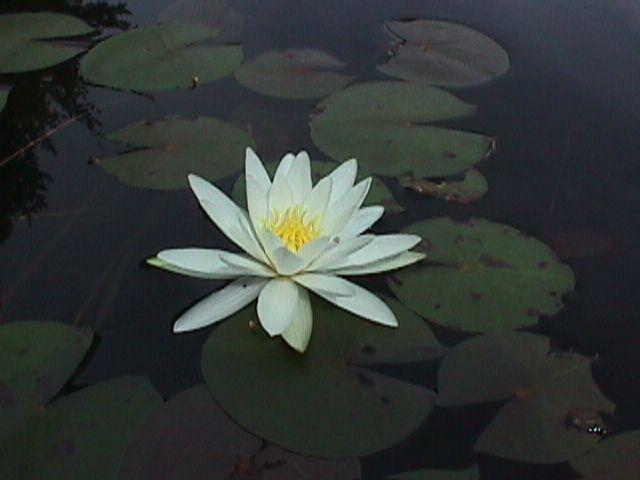


This native perennial plant is a floating aquatic that can grow in water up to 8' deep. The leaves develop directly from the rootstock on long petioles. They are 4-12" across, orbicular in shape, cleft toward the middle on one side, and smooth along the outer margins. The upper surface of the leaf is medium green, while the lower surface is often purplish; its texture is rather leathery and thick. Fine veins radiate outward from the center of the leaf. The air pores through which the leaf breathes are located on the upper surface, rather than the lower surface (unlike the leaves of most plants). The long petiole of each leaf is terete, stout, and purplish; it is often covered with algae.
Long flowering stalks also develop directly from the rootstock; each stalk is unbranched and bears a single floating flower at its apex. The appearance of these stalks resembles the petioles of the leaves. Each flower is about 3-6" across; it has 4 greenish white sepals on the bottom that rest on the water surface, and about 20-30 white petals above. In the middle of the petals, there are many golden yellow stamens surrounding a single pistil. The petals are elliptic-lanceolate and they curve slightly upward. The outer stamens have winged filaments that are broader than the anthers, while the inner stamens have narrow filaments. The blooming period occurs during the summer and early fall. Each flower lasts only 3-4 days; it opens up during the morning and closes during the afternoon. The flowers are quite fragrant. After the petals wither away, a multicelled fruit develops that is globoid; the stalk of this fruit bends downward and it matures underwater. Eventually, this fruit releases its seeds which float upward to the surface of the water. After being carried about by water currents and the wind, they sink downward to the bottom, where they can germinate. The root system consists of long forking rhizomes and coarse fibrous roots. Vegetative colonies are often formed.